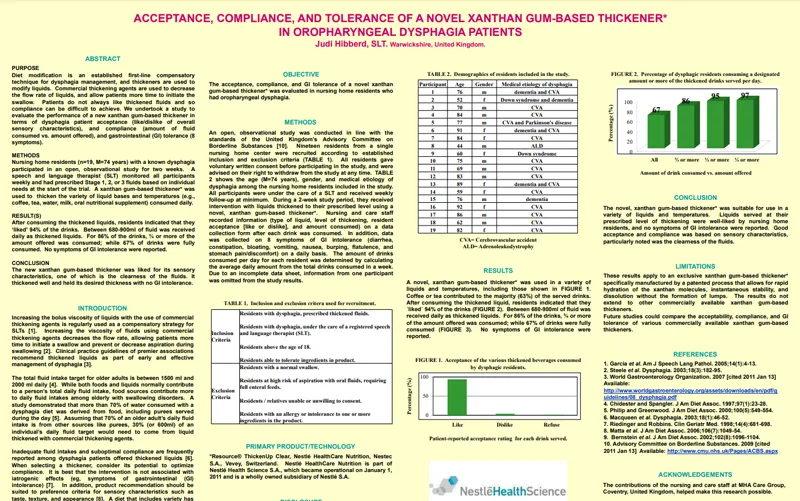Dysphagia
13 Results found
Highlight of the month

Cheng I et al. 2025 Understanding health care professionals’ knowledge and practice regarding malnutrition and dysphagia: insights from Targeted Education to Address Malnutrition and Swallowing disorders (TEAMS) international survey
In this international survey, it explores current knowledge gaps regarding malnutrition and dysphagia among healthcare professionals across 54 countries and discusses opportunties for improved care, management and identification strategies.
See moreExternal Link
In this meta-analysis of randomised control trials, it details how texture-modified diets increase dietary intake of energy and protein in addition to fluif intake for adults with dysphagia.
This case report presents the clinical experience with four cases of post-stroke dysphagia. A comprehensive approach to management with thickened fluids decreased the risk of aspiration pneumonia and facilitated effective management of dietary recommendations both during hospitalisation and after discharge.
This literature review demonstrates that the EAT-10 dysphagia screening tool can be used as a primary screening instrument for detecting dysphagia in routine clinical practice, and provides complementary information to other diagnostic tools.
This study aims at Identifying the risk factors for dysphagia in ICU patients with COVID-19 pneumonia requiring invasive mechanical ventilation, and at determining the frequency of postextubation dysphagia in this population.
This clinical paper reviews the evidence available on the use of thickening agents for the management of dysphagia. It includes discussion on different types of thickeners, and looks at their effects on the bioavailability of water, absorption of medications and feelings of satiety when consuming different viscosities.
This study investigates the therapeutic effect of a xantham-gum based thickener on the swallowing function of patients with dysphagia. Results demonstrated that the xanthan-gum based thickener improves the safety of swallow without increasing residue providing a viscosity-dependent therapeutic effect for patients with oropharyngeal dysphagia.
This study assesses the feasibility of thickening video fluoroscopic contrast agents for dysphagia, including using a xantham gum-based thickener. The results showed that for optimal patient outcomes, only diagnostic materials and thickening agents for which reliable viscosity data are available should be used.
The use of thickening agents to alter bolus rheology is particularly commonplace; however, the precise effects of these alterations on swallowing remain uncertain. The aim of this study was to compare the effects of a thin contrast fluid versus a contrast fluid thickened with a xanthan gum-based thickener and a starch-based thickener.
This comparative study investigates the safety and efficacy of a xanthan gum-based versus a starch-based thickener in post-stroke patients with oropharyngeal dysphagia. Both thickeners were effective in improving swallowing safety however the xanthan gum-based thickener does not increase the prevalence of oral and pharyngeal residue, better avoiding the risk of aspiration after the swallow.
This publication provides current knowledge on pureed foods for people with dysphagia, developed by 6 global experts. Topics include chewing and swallowing solid foods, tools for screening and assessment, texture-modified diets in residential care settings, and benefits of commercially prepared pureed foods. Author: Experts on Chewing and Swallowing disorders and Nestlé Nutrition Institute
This systematic review explores the prevalence of dehydration in oropharyngeal dysphagia (OD), the relationship between OD severity and dehydration severity, the effect of thickened fluid therapy on hydration status in OD patients, and any potential negative or positive effect of thickened fluid therapy on hydration status. Click here to view the video
An open, observational study that was conducted to look at the acceptance, compliance and gastrointestinal (GI) tolerance of a xanthan gum-based thickener in aged care residents with dysphagia. The study found that the xanthan gum-based thickener was liked for its sensory characteristics, thickened well and held it's desired thickness with no GI intolerance.



